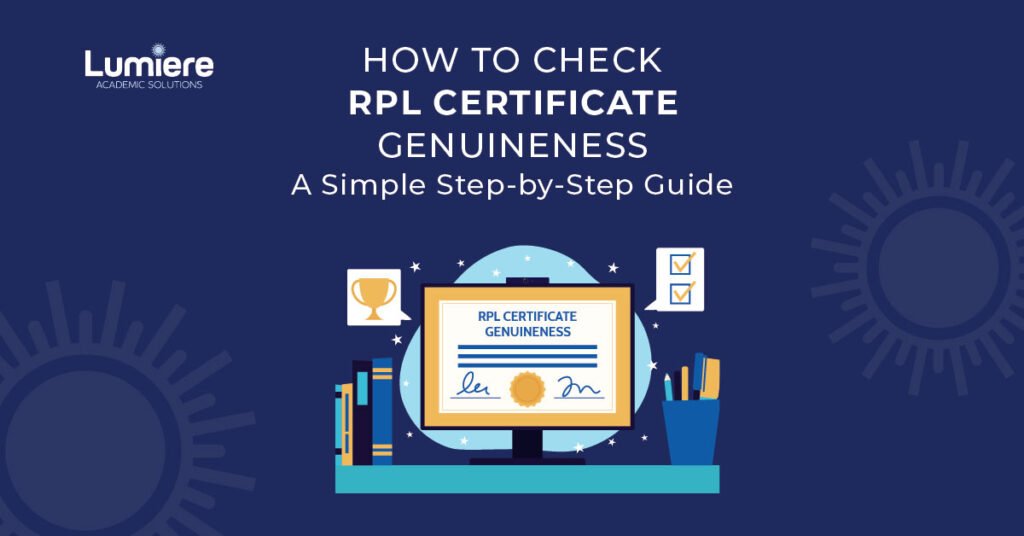
Australia has witnessed a surge in fake RPL providers exploiting the system for financial gain. Unfortunately, checking the genuineness of your RPL certificate has become essential in today’s qualification landscape. According to research by the Australian Skills Quality Authority (ASQA), unethical marketing of RPL services is negatively impacting student expectations and damaging the sector’s reputation.
When your RPL certification process takes between 4 to 12 weeks to complete, the last thing you want is to discover that your RPL certificate in Australia isn’t recognized. This is especially concerning since RPL qualifications are crucial for many visa application processes and are increasingly recognized internationally. Thankfully, we’ve developed a comprehensive RPL check system and RPL checklist to help you verify the legitimacy of your credentials. As a trusted RPL solution provider in Australia, Lumiere Solutions understands the importance of authentic qualifications.
In this article, we’ll guide you through simple yet effective steps to verify your RPL certificate and protect yourself from scammers who could potentially derail your career prospects.
Why RPL Certificate Scams Are a Growing Concern
The proliferation of fraudulent RPL certificates has become a significant issue in Australia’s vocational education and training sector. Recent investigations reveal that the problem is widespread and deeply entrenched, with potentially thousands of unqualified individuals holding fake credentials. This growing trend undermines legitimate qualifications and creates numerous problems for stakeholders across the industry.
How fake RPL certificates affect careers
Fake RPL certificates create an uneven playing field in the job market. Genuine candidates who invest time and resources into obtaining legitimate qualifications find themselves competing unfairly with those who purchased fraudulent credentials. Furthermore, unqualified individuals in positions of influence perpetuate a cycle of incompetence, where mentorship and decision-making are compromised.
In the construction sector alone, carpenters represent 80% of the licenses canceled due to fraudulent qualifications. Industry sources believe up to one in three license holders across New South Wales obtained their qualifications fraudulently. Consequently, this leads to poor workmanship, creating building defects that cost the state approximately AUD 1070.29 million annually.
Impact on the credibility of the VET sector
The integrity of Australia’s entire VET system faces serious challenges due to certificate scams. The VET FEE-HELP scandal cost Australian taxpayers around AUD 11.47 billion, highlighting the enormous financial impact of fraudulent activities.
Additionally, ASQA’s integrity unit has undertaken 113 unannounced raids on providers offering training to overseas students. As of December 2023, ASQA was handling 174 serious matters involving 138 training providers, with 68% of these cases involving fraud. These numbers demonstrate why verifying your RPL certificate has become crucial.
Common scam tactics used by fake providers
Fraudulent providers employ various deceptive tactics to exploit unsuspecting individuals:
- “Tick and flick” processes, where assessors simply check off skills without proper verification
- Misrepresenting eligibility for qualifications through unqualified call center staff
- Falsely promising “100% money back guarantees” while consistently declining refund requests.
- Using high-pressure sales tactics and requiring upfront payments
- Issuing qualifications with outdated or incorrect course codes
- Delivering courses that should be entirely practical online
Importantly, legitimate RPL providers like Lumiere Solutions follow proper assessment protocols and maintain transparency throughout the certification process. Performing an RPL check before engaging with any provider can protect you from these increasingly sophisticated scams that threaten both individual careers and the reputation of Australia’s educational institutions.
6 Simple Ways to Check if Your RPL Certificate is Genuine
Protecting yourself from fraudulent RPL certificates requires vigilance and attention to detail. I’ve compiled six practical verification methods that anyone can use to confirm the legitimacy of their RPL certification.
1. Verify the RTO registration on training.gov.au
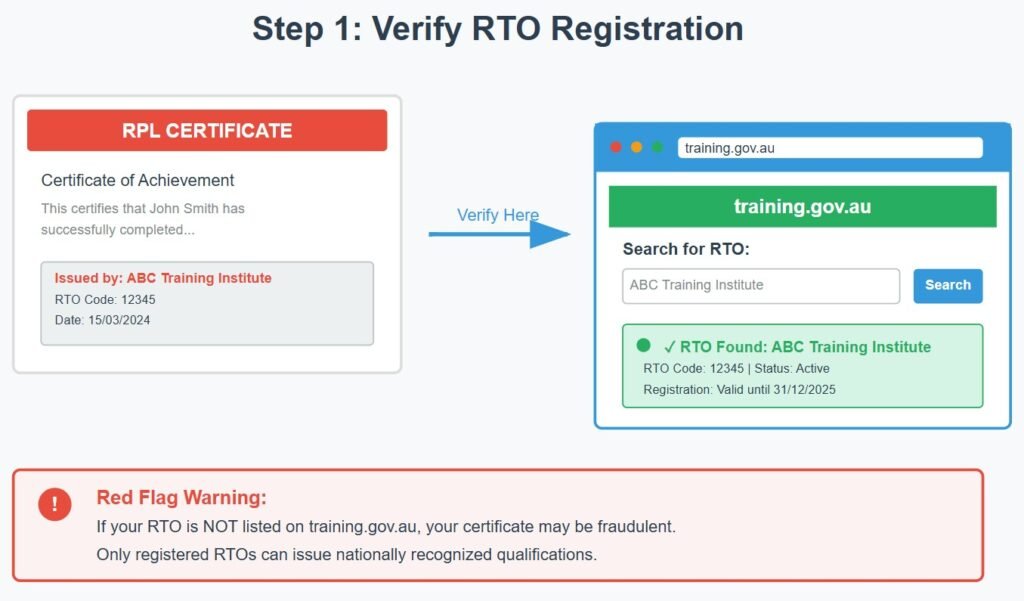
Initially, check if the Registered Training Organization (RTO) that issued your certificate is properly registered. Visit training.gov.au, the official national register for RTOs, and search for the organization by name or code. Any legitimate provider must be listed here, as only registered RTOs are authorized to issue nationally recognized qualifications and statements of attainment. If your provider isn’t listed, that’s an immediate red flag.
2. Check for official logos, watermarks, and QR codes
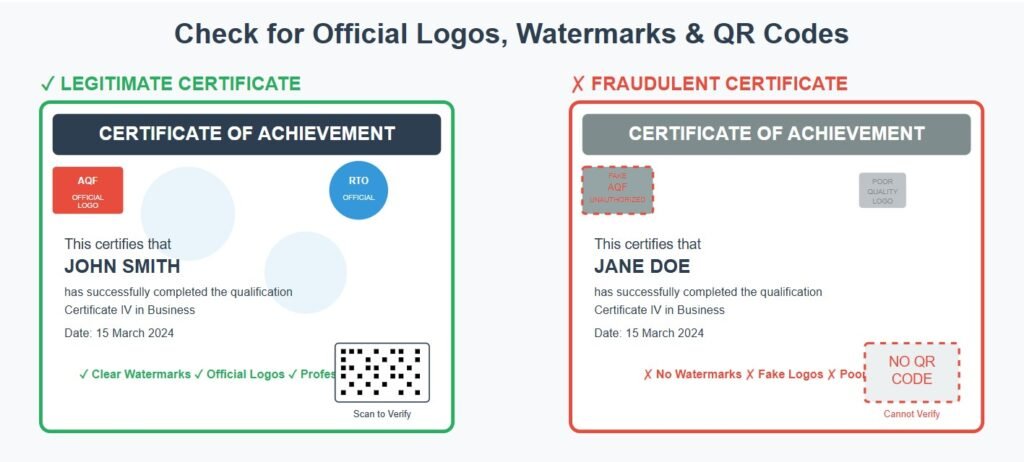
Authentic certificates typically include security features like watermarks of the official RTO logo in the background. Current certificates often contain QR codes for verification purposes. Moreover, check for the AQF logo – only registered providers are permitted to use this on testamurs, while unregistered providers must not use it for any reason.
3. Review the certificate number and format
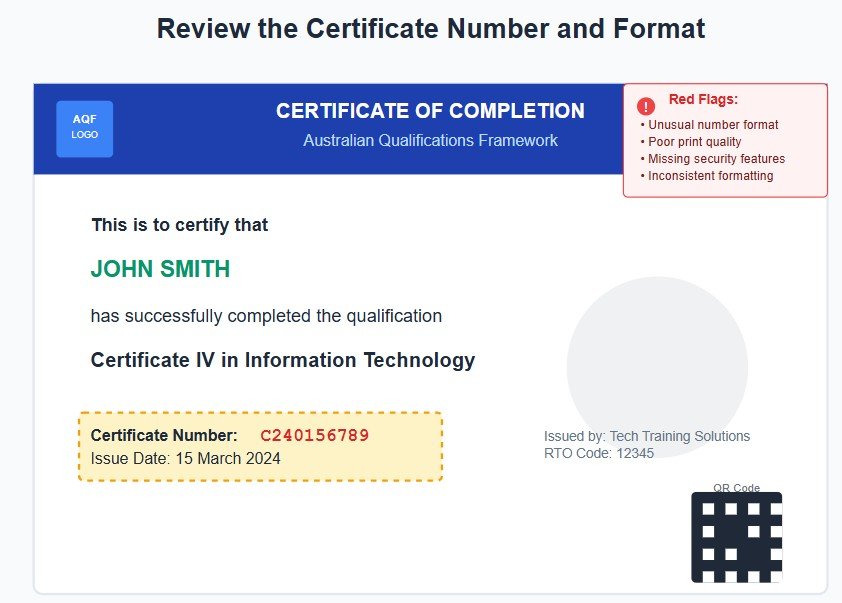
Examine the certificate number carefully. Legitimate RTOs follow specific patterns for certificate numbering. For instance, some providers’ certificate numbers start with a specific format (like “CXXXXX”). The format and presentation should be consistent with official documents.
4. Cross-check the qualification with the AQF framework
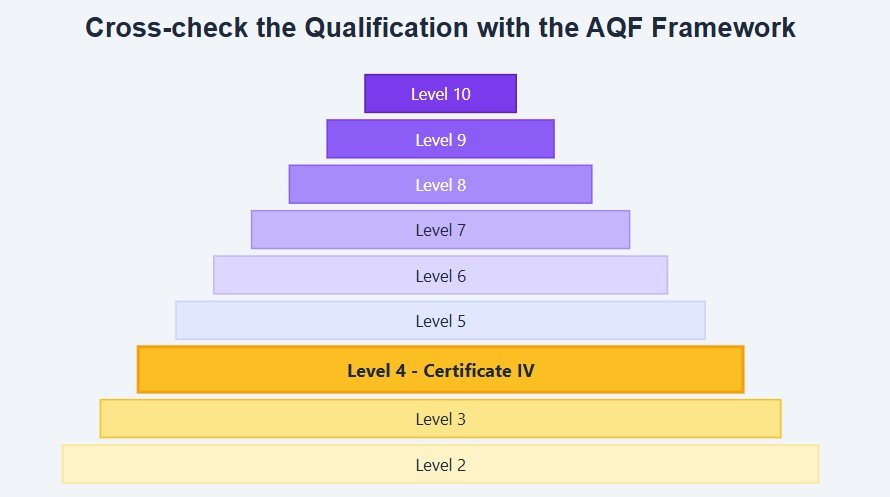
Ensure your qualification aligns with the Australian Qualifications Framework. The AQF includes a pathways policy that provides information for students and providers. Legitimate qualifications must match established learning outcomes within this framework.
5. Contact the issuing RTO directly for confirmation
Specifically, reach out to the RTO using contact information found on their official website or from training.gov.au – never use contacts provided on the certificate itself. RTOs can verify that the certificate number was allocated to you. For training completed after January 2015, verification can also be done through the USI Transcript Service.
6. Compare transcript details with official templates
Finally, scrutinize your transcript’s format against known official templates. Authentic transcripts follow standard formats, including proper labeling of results, consistent logos, and specific formatting features. At Lumiere Solutions, we recommend keeping a detailed RPL checklist for verification to protect your professional credibility.
What a Legitimate RPL Process Should Look Like
Understanding the elements of a legitimate RPL process is essential for recognizing when an assessment meets industry standards. A thorough RPL validation ensures your qualification will withstand any RPL check and maintain its value in the job market.
Qualified assessors and proper evidence review
Legitimate RPL assessments must be conducted by qualified assessors with comprehensive knowledge of the industry and qualification criteria. These professionals possess strong analytical abilities and maintain ethical, unbiased decision-making skills throughout the evaluation process. When reviewing your RPL certificate in Australia, note that proper assessors:
- Verify evidence against the rules of evidence – ensuring it’s valid, authentic, current, and sufficient.
- Scrutinize evidence to determine its relevance to specific competencies.
- Provide constructive feedback, particularly when evidence gaps exist.
- Regularly update their industry knowledge to ensure accurate assessments
Assessors must comply with the Standards for Registered Training Organizations 2015, maintaining transparency and consistency in their evaluation methods.
Gap training options for incomplete competencies
Reputable providers like Lumiere Solutions recognize that not all applicants possess complete evidence for all competencies. Accordingly, legitimate RTOs offer gap training to address any skill deficiencies identified during assessment. This training complements the RPL process by filling knowledge gaps rather than requiring complete retraining.
In essence, genuine providers understand that achieving a qualification often involves both RPL and targeted gap training. This combined approach ensures comprehensive skill verification while acknowledging prior experience.
Transparent communication and documentation
Throughout the RPL certification process, transparent communication remains paramount. Legitimate providers maintain comprehensive documentation, including:
Records of assessment decisions with clear rationales, Systematic procedures for collecting and evaluating evidence, Accessible processes for candidates to appeal assessment outcomes, Detailed feedback explaining judgments, and identifying strengths
Undoubtedly, proper documentation serves as your protection against future questions about your qualifications. When conducting your RPL checklist verification, ensure your provider maintains these communication standards throughout the certification journey.
What to Do If You Suspect a Fake RPL Certificate
Discovering a potentially fraudulent RPL certificate requires immediate action. Whether you’re an employer verifying credentials or an individual who suspects your certificate lacks authenticity, following proper channels ensures an appropriate resolution.
Steps to report to ASQA or the relevant authorities
If you suspect a fake RPL certificate, first contact the training organization directly to address your concerns. This allows them to clarify any misunderstandings. Subsequently, if your suspicions remain, report the matter to the Australian Skills Quality Authority (ASQA) through their official channels:
- Submit a report via the ASQA stakeholder portal (ASQAconnect)
- Use their online Tip-off form for suspected fraudulent activities.
- Contact the National Training Complaints Hotline established through collaboration between Commonwealth, state, and territory governments.
ASQA cannot make private rulings on certificate legitimacy, nonetheless, they investigate reports of bogus qualifications and take regulatory action against non-compliant providers.
How to protect yourself from future scams
To avoid falling victim to RPL scams henceforth:
- Stop and check before acting on offers that seem too good to be true.
- Be wary of providers requiring upfront payment before sharing important qualification requirements.
- Avoid paying with preloaded debit cards, iTunes cards, or virtual currency.
- Watch out for “follow-up scams” – scammers often target previous victims again.
- Verify qualifications through the USI Transcript Service for training completed after January 2015
Remember that legitimate RPL providers never pressure you with artificial time constraints or use aggressive marketing tactics.
Seeking help from trusted providers like Lumiere Solutions
Trusted RPL providers like Lumiere Solutions offer guidance through the verification process. They can help you understand what constitutes a genuine qualification and advise on steps if you suspect fraudulent documentation. Their expertise is particularly valuable in navigating the complexities of the Australian qualifications framework.
For detailed guidance on RPL certificate verification or to discuss concerns about existing qualifications, contact Lumiere Solutions through their website (lumieresolutions.com.au). Their transparent approach to RPL certification helps protect the integrity of your professional credentials and ensures your qualifications stand up to any legitimacy check.
Conclusion
Authentic RPL certifications play a crucial role in building legitimate careers and maintaining the integrity of Australia’s qualification system. Throughout this article, we’ve seen how scammers exploit vulnerabilities in the RPL process, consequently damaging both individual careers and the broader VET sector. Therefore, verification of your RPL certificate must become a non-negotiable step in your qualification journey.
The six verification methods we’ve outlined—from checking RTO registration to scrutinizing certificate details—provide you with practical tools to protect yourself from fraud. Above all, remember that legitimate RPL processes involve qualified assessors, proper evidence review, gap training options, and transparent documentation. These elements distinguish authentic providers from those looking to make quick profits at your expense.
What happens if you discover your certificate might be fraudulent? Most importantly, take immediate action through proper reporting channels and protect yourself from future scams by exercising due diligence. Legitimate providers like Lumiere Solutions (lumieresolutions.com.au) stand ready to guide you through proper RPL certification processes that meet all regulatory requirements.
Your career deserves the foundation of genuine qualifications. Undoubtedly, the extra time spent verifying your RPL certificate’s authenticity will save you countless headaches later. The steps outlined in this guide will help safeguard your professional credibility and ensure your qualifications stand up to scrutiny. After all, true success comes not just from having certifications, but from having certifications you can trust and defend with confidence.

